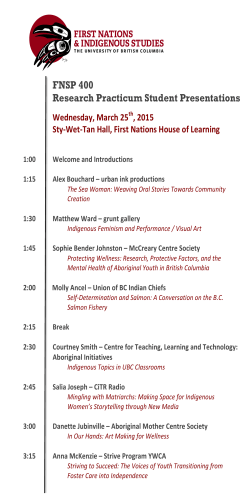
Dr Jenine Godwin-Thompson â Exploring attachment & Aboriginal
27/03/2015 Centre of knowledge EXPLORING ‘ATTACHMENT’ AND PARENTING PERSPECITVES WITH ABORIGINAL EXPERIENCE Dr Jenine Godwin-Thompson Snapshot Important to know history to: Understand how it impacts on peoples world views and their perceptions of others • Era of European (1788-1880) - Dispossession - Introduced Disease - Dispossession - Introduced Disease Understand how it positions different groups in society and how it impacts on the health and wellbeing of the different groups SSnapshot Snapshot Era of Self Determination and Self Management (1967 - present) napshot • Era of Segregation and Protection - Loss of Lifestyle - Loss of Social cohesion - Assimilation (1950s-1960s) 1 27/03/2015 Summary issues of consideration: • • • • • Assimilation Policy Stolen Generation Native Title Royal Commission into Aboriginal Death in Custody (1987) Self Determination and Self Management ABORIGINALWORLDVIEW The starting point for wellbeing is always cultural in that it is defined, understood and experienced within a social, natural and material environment, which is understood and acted on in terms of the cultural understandings that people have developed to enable them to interact within their world (Grieves 2006a:12-19). TO UNDERSTAND OUR LAW, OUR CULTURE AND OUR RELATIONSHIP TO THE PHYSICAL AND SPIRITUAL WORLD YOU MUST BEGIN WITH THE LAND. EVERYTHING ABOUT ABORIGINAL SOCIETY IS INEXTRICABLY INTERWOVEN WITH, AND CONNECTED TO, THE LAND. CULTURE IS THE LAND … YOU TAKE THAT AWAY AND YOU TAKE AWAY OUR REASON FOR EXISTENCE ... REMOVED FROM OUR LANDS, WE ARE LITERALLY REMOVED FROM OURSELVES (DODSON 1997:6). Country is multidimensional–it consists of people, animals, plants, Dreamings; underground, earth, soils, minerals and waters, air … People talk about country in the same way that they would talk about a person: they speak to country, sing to country, worry about country, feel sorry for country, and long for country (Rose 1996:7). This holistic concept does not merely refer to the ‘whole body’, but in fact is steeped in the harmonized inter-relations, which constitute cultural wellbeing. These inter-relating factors can be categorized largely as spiritual, environmental, ideological, political, social, economic, mental and physical (Swan and Raphael 1995:13). WESTERN/ EUROPEAN WORLDVIEW Dreaming Religious and scientific Unchanging Process and change Land custodians maintain and preserve the land, air, sea and animals Land ownership (bought and sold) Health - holistic and relational, spiritual cause behind the illness and/ or injury; traditional healers and bush medicine Measuring, counting, analysing and dissecting. Health and wellbeing, and death are separate. Individualbased system Oral - passed through kinship systems Written - books and documents Societal emphasis is on group obligations and responsibility Individualism High value on belonging [to Country and kin] Independence Resources shared Resources earned and paid for Non-hierarchical/consensus Hierarchical - status through achievement, corporate success, academic achievement Knowledge of life Academic, research, business, technological, economic Use of time - relationship is priority and time taken is less important Use of time - efficient cost effective, outcome driven Aboriginal health is not just the physical well-being of the individual, but the social, emotional , spiritual and cultural well-being of the whole community. It is a whole of life view and it includes the concept of lifedeath-life. 2 27/03/2015 Individuals turn to alcohol, Three contributing factors to homelessness: drugs and tobacco, other drugs and suffer from use, use is (i) separation from home country or homeland, and a subsequent sense of 'not belonging' in one's place of residence; influenced by wider social (ii) separation from family and kinship networks (including 'Stolen Generation' persons); and setting (iii) not knowing about one's Indigenous identity and consequently one's role and place in any Aboriginal community. “ … problems experience by Aboriginal and Torres Strait Islander people such as low self-esteem, poor mental health, a lack of well-being and substance abuse are seen to have their roots in this form of homelessness” (Keys Young 1999:28). Drug use a response to social breakdown, worsening inequalities in health Offers escape from stress and reality The concept was first discussed in a consultancy report for government in 1998 by the firm of Keys Young Definition of spiritually homeless: "most fundamental form of homelessness in the Indigenous context is the notion of homelessness as a state of mind, an essentially spiritual rather than a physical state of being". (Keys Young 1999:28) What can we do for more effective outcomes to be ‘culturally responsive’ • • • • • • • Better understanding from both sides. Recognition and respect for Indigenous knowledge's – ‘attachment’ More Aboriginal people in power positions Capacity building and empowerment – Aboriginal people and people who work in an Aboriginal context Whole of government and community approach Policies and funding criteria which promote a holistic approach Research which produces solutions Services must be: Accessible Relevant to the needs of the population/community Functionally integrated Based on community participation Cost effective Characterised by intersectorial collaboration 3
© Copyright 2025










